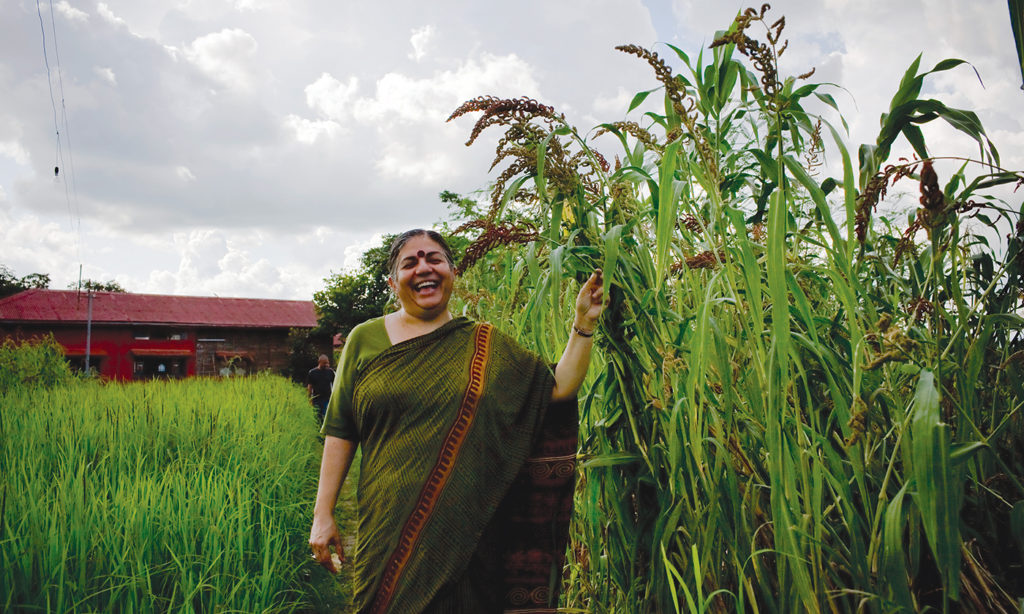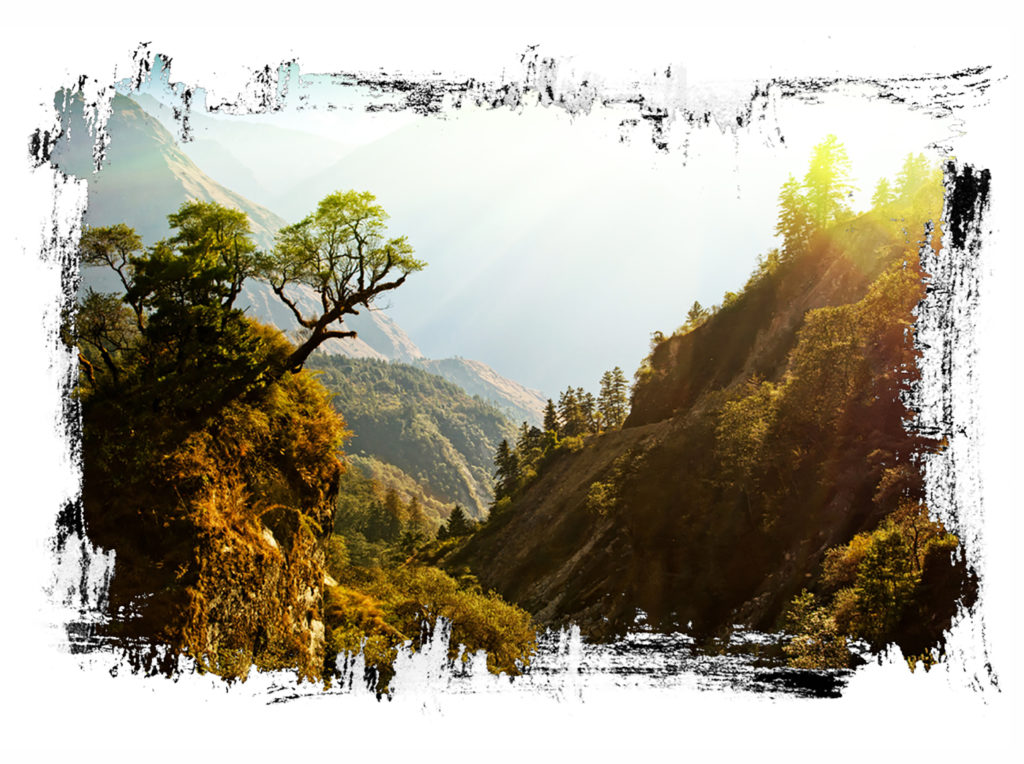Everything I Need to Know I Learned in the Forest
TRANSCEND MEMBERS, 13 May 2019
Prof. Vandana Shiva – YES! Magazine
We need to value nature’s biodiversity, clean water, and seeds. For this, nature is the best teacher.

Vandana Shiva at her biodiversity farm, Navdanya, which is also where the Earth University is located. Participants learn humans’ role and responsibility in Earth Democracy, and they work with seeds and soil as living things, in the context of the entire web of life. Photo by Suzanne Lee
3 May 2019 – My ecological journey started in the forests of the Himalaya. My father was a forest conservator, and my mother became a farmer after fleeing the tragic partition of India and Pakistan. It is from the Himalayan forests and ecosystems that I learned most of what I know about ecology. The songs and poems our mother composed for us were about trees, forests, and India’s forest civilizations.
My involvement in the contemporary ecology movement began with Chipko, a nonviolent response to the large-scale deforestation that was taking place in the Himalayan region.
In the 1970s, peasant women from my region in the Garhwal Himalaya had come out in defense of the forests.
Logging had led to landslides and floods, and scarcity of water, fodder, and fuel. Since women provide these basic needs, the scarcity meant longer walks for collecting water and firewood, and a heavier burden.
Women knew that the real value of forests was not the timber from a dead tree, but the springs and streams, food for their cattle, and fuel for their hearths. The women declared that they would hug the trees, and the loggers would have to kill them before killing the trees.
A folk song of that period said:
These beautiful oaks and rhododendrons,
They give us cool water
Don’t cut these trees
We have to keep them alive.
In 1973, I had gone to visit my favorite forests and swim in my favorite stream before leaving for Canada to do my Ph.D. But the forests were gone, and the stream was reduced to a trickle.
I decided to become a volunteer for the Chipko movement, and I spent every vacation doing pad yatras (walking pilgrimages), documenting the deforestation and the work of the forest activists, and spreading the message of Chipko.
One of the dramatic Chipko actions took place in the Himalayan village of Adwani in 1977, when a village woman named Bachni Devi led resistance against her own husband, who had obtained a contract to cut trees. When officials arrived at the forest, the women held up lighted lanterns although it was broad daylight. The forester asked them to explain. The women replied, “We have come to teach you forestry.” He retorted, “You foolish women, how can you prevent tree felling by those who know the value of the forest? Do you know what forests bear? They produce profit and resin and timber.”
The women sang back in chorus:
What do the forests bear?
Soil, water, and pure air.
Soil, water, and pure air
Sustain the Earth and all she bears.
Beyond monocultures
From Chipko, I learned about biodiversity and biodiversity-based living economies; the protection of both has become my life’s mission. As I described in my book Monocultures of the Mind, the failure to understand biodiversity and its many functions is at the root of the impoverishment of nature and culture.
The lessons I learned about diversity in the Himalayan forests I transferred to the protection of biodiversity on our farms. I started saving seeds from farmers’ fields and then realized we needed a farm for demonstration and training. Thus Navdanya Farm was started in 1994 in the Doon Valley, located in the lower elevation Himalayan region of Uttarakhand Province. Today we conserve and grow 630 varieties of rice, 150 varieties of wheat, and hundreds of other species. We practice and promote a biodiversity-intensive form of farming that produces more food and nutrition per acre. The conservation of biodiversity is therefore also the answer to the food and nutrition crisis.
When nature is a teacher, we cocreate with her.
Navdanya, the movement for biodiversity conservation and organic farming that I started in 1987, is spreading. So far, we’ve worked with farmers to set up more than 100 community seed banks across India. We have saved more than 3,000 rice varieties. We also help farmers make a transition from fossil fuel and chemical-based monocultures to biodiverse ecological systems nourished by the sun and the soil.
Biodiversity has been my teacher of abundance and freedom, of cooperation and mutual giving.
Rights of nature on the global stage
When nature is a teacher, we cocreate with her—we recognize her agency and her rights. That is why it is significant that Ecuador has recognized the “rights of nature” in its constitution. In April 2011, the United Nations General Assembly—inspired by the constitution of Ecuador and the Universal Declaration of the Rights of Mother Earth initiated by Bolivia—organized a conference on harmony with nature as part of Earth Day celebrations. Much of the discussion centered on ways to transform systems based on domination of people over nature, men over women, and rich over poor into new systems based on partnership.
The U.N. secretary general’s report “Harmony with Nature,” issued in conjunction with the conference, elaborates on the importance of reconnecting with nature: “Ultimately, environmentally destructive behavior is the result of a failure to recognize that human beings are an inseparable part of nature and that we cannot damage it without severely damaging ourselves.”
Separatism is indeed at the root of disharmony with nature and violence against nature and people. As the prominent South African environmentalist Cormac Cullinan points out, apartheid means separateness. The world joined the anti-apartheid movement to end the violent separation of people on the basis of color. Apartheid in South Africa was put behind us. Today, we need to overcome the wider and deeper apartheid—an eco-apartheid based on the illusion of separateness of humans from nature in our minds and lives.
The dead-Earth worldview
The war against the Earth began with this idea of separateness. Its contemporary seeds were sown when the living Earth was transformed into dead matter to facilitate the industrial revolution. Monocultures replaced diversity. “Raw materials” and “dead matter” replaced a vibrant Earth. Terra Nullius (the empty land, ready for occupation regardless of the presence of Indigenous peoples) replaced Terra Madre (Mother Earth).
This philosophy goes back to Francis Bacon, called the father of modern science, who said that science and the inventions that result do not “merely exert a gentle guidance over nature’s course; they have the power to conquer and subdue her, to shake her to her foundations.”
Robert Boyle, the famous 17th-century chemist and a governor of the Corporation for the Propagation of the Gospel Among the New England Indians, was clear that he wanted to rid native people of their ideas about nature. He attacked their perception of nature “as a kind of goddess” and argued that “the veneration, wherewith men are imbued for what they call nature, has been a discouraging impediment to the empire of man over the inferior creatures of God.”
The death-of-nature idea allows a war to be unleashed against the Earth. After all, if the Earth is merely dead matter, then nothing is being killed.
As philosopher and historian Carolyn Merchant points out, this shift of perspective—from nature as a living, nurturing mother to inert, dead, and manipulable matter—was well suited to the activities that would lead to capitalism. The domination images created by Bacon and other leaders of the scientific revolution replaced those of the nurturing Earth, removing a cultural constraint on the exploitation of nature. “One does not readily slay a mother, dig into her entrails for gold, or mutilate her body,” Merchant wrote.
What nature teaches
Today, at a time of multiple crises intensified by globalization, we need to move away from the paradigm of nature as dead matter. We need to move to an ecological paradigm, and for this the best teacher is nature herself.
This is the reason I started the Earth University/Bija Vidyapeeth at Navdanya’s farm.
The Earth University teaches Earth Democracy, which is the freedom for all species to evolve within the web of life, and the freedom and responsibility of humans, as members of the Earth family, to recognize, protect, and respect the rights of other species. Earth Democracy is a shift from anthropocentrism to ecocentrism. And since we all depend on the Earth, Earth Democracy translates into human rights to food and water, to freedom from hunger and thirst.
Because the Earth University is located at Navdanya, a biodiversity farm, participants learn to work with living seeds, living soil, and the web of life. Participants include farmers, schoolchildren, and people from across the world. Two of our most popular courses are “The A-Z of Organic Farming and Agroecology” and “Gandhi and Globalization.”
The poetry of the forest
The Earth University is inspired by Rabindranath Tagore, India’s national poet and a Nobel Prize laureate.
Tagore started a learning center in Shantiniketan in West Bengal, India, as a forest school, both to take inspiration from nature and to create an Indian cultural renaissance. The school became a university in 1921, growing into one of India’s most famous centers of learning.
Today, just as in Tagore’s time, we need to turn to nature and the forest for lessons in freedom.
The forest teaches us enoughness.
In “The Religion of the Forest,” Tagore wrote about the influence that the forest dwellers of ancient India had on classical Indian literature. The forests are sources of water and the storehouses of a biodiversity that can teach us the lessons of democracy—of leaving space for others while drawing sustenance from the common web of life. Tagore saw unity with nature as the highest stage of human evolution.
In his essay “Tapovan” (Forest of Purity), Tagore writes: “Indian civilization has been distinctive in locating its source of regeneration, material and intellectual, in the forest, not the city. India’s best ideas have come where man was in communion with trees and rivers and lakes, away from the crowds. The peace of the forest has helped the intellectual evolution of man. The culture of the forest has fueled the culture of Indian society. The culture that has arisen from the forest has been influenced by the diverse processes of renewal of life, which are always at play in the forest, varying from species to species, from season to season, in sight and sound and smell. The unifying principle of life in diversity, of democratic pluralism, thus became the principle of Indian civilization.”
It is this unity in diversity that is the basis of both ecological sustainability and democracy. Diversity without unity becomes the source of conflict and contest. Unity without diversity becomes the ground for external control. This is true of both nature and culture. The forest is a unity in its diversity, and we are united with nature through our relationship with the forest.
In Tagore’s writings, the forest was not just the source of knowledge and freedom; it was the source of beauty and joy, of art and aesthetics, of harmony and perfection. It symbolized the universe.
In “The Religion of the Forest,” the poet says that our frame of mind “guides our attempts to establish relations with the universe either by conquest or by union, either through the cultivation of power or through that of sympathy.”
The forest teaches us union and compassion.
The forest also teaches us enoughness: as a principle of equity, how to enjoy the gifts of nature without exploitation and accumulation. Tagore quotes from the ancient texts written in the forest: “Know all that moves in this moving world as enveloped by God; and find enjoyment through renunciation, not through greed of possession.” No species in a forest appropriates the share of another species. Every species sustains itself in cooperation with others.
The end of consumerism and accumulation is the beginning of the joy of living.
The conflict between greed and compassion, conquest and cooperation, violence and harmony that Tagore wrote about continues today. And it is the forest that can show us the way beyond this conflict.
_______________________________________________
Vandana Shiva wrote this article for What Would Nature Do?, the Winter 2012 issue of YES! Magazine.
 TRANSCEND Member Prof. Vandana Shiva is a physicist, ecofeminist, philosopher, activist, and author of more than 20 books and 500 papers. She is the founder of the Research Foundation for Science, Technology and Ecology, and has campaigned for biodiversity, conservation and farmers’ rights, winning the Right Livelihood Award [Alternative Nobel Prize] in 1993. She is executive director of the Navdanya Trust.
TRANSCEND Member Prof. Vandana Shiva is a physicist, ecofeminist, philosopher, activist, and author of more than 20 books and 500 papers. She is the founder of the Research Foundation for Science, Technology and Ecology, and has campaigned for biodiversity, conservation and farmers’ rights, winning the Right Livelihood Award [Alternative Nobel Prize] in 1993. She is executive director of the Navdanya Trust.
Navdanya and the Navdanya movement were created by Dr. Vandana Shiva 30 years ago in India to defend Seed and Food sovereignty and small farmers around the world. Navdanya pioneered the movement of seed saving and seed freedom, which began in response to the crisis of erosion of agricultural biodiversity and introduction of GMOs and patents on seeds through intellectual property rights (IPRs) and so-called ‘free trade’ agreements. It has long fought against biopiracy, the patenting of indigenous knowledge by self-interested multinational corporations and won cases related to Neem, basmati rice and wheat in India. Navdanya promotes a new agricultural and economic paradigm, a culture of food for health, where ecological responsibility and economic justice replace the present greed, consumerism and competition which have become dominant in society. It aims at regaining the common good as a foundation for a renewed sense of community, solidarity and culture of peace. We strive to achieve these goals through the conservation, renewal and rejuvenation of the gifts of biodiversity we have received from nature and our ancestors, and to defend these gifts as commons. More…
Go to Original – yesmagazine.org
Tags: Activism, Development, Economics, Environment, Health, Nonviolence, Peace, Politics, Solutions, Sustainability
DISCLAIMER: The statements, views and opinions expressed in pieces republished here are solely those of the authors and do not necessarily represent those of TMS. In accordance with title 17 U.S.C. section 107, this material is distributed without profit to those who have expressed a prior interest in receiving the included information for research and educational purposes. TMS has no affiliation whatsoever with the originator of this article nor is TMS endorsed or sponsored by the originator. “GO TO ORIGINAL” links are provided as a convenience to our readers and allow for verification of authenticity. However, as originating pages are often updated by their originating host sites, the versions posted may not match the versions our readers view when clicking the “GO TO ORIGINAL” links. This site contains copyrighted material the use of which has not always been specifically authorized by the copyright owner. We are making such material available in our efforts to advance understanding of environmental, political, human rights, economic, democracy, scientific, and social justice issues, etc. We believe this constitutes a ‘fair use’ of any such copyrighted material as provided for in section 107 of the US Copyright Law. In accordance with Title 17 U.S.C. Section 107, the material on this site is distributed without profit to those who have expressed a prior interest in receiving the included information for research and educational purposes. For more information go to: http://www.law.cornell.edu/uscode/17/107.shtml. If you wish to use copyrighted material from this site for purposes of your own that go beyond ‘fair use’, you must obtain permission from the copyright owner.
